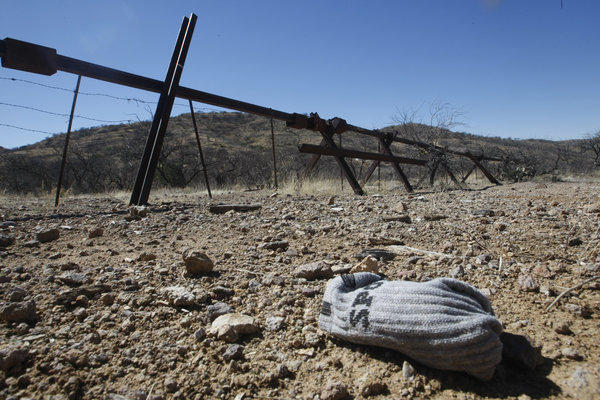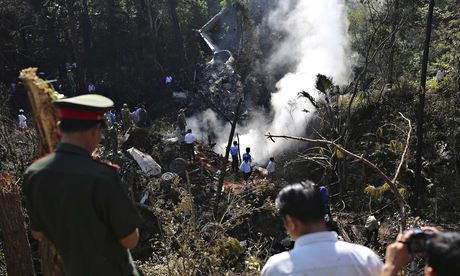
Corina Montoya cries as she holds her granddaughter in her arms.
Angie will turn 2 soon. She was just 18 days old when her father left their home in El Progreso, Honduras. Hector Rivas hasn't been heard from since he headed to the United States in 2012 with the dream of buying a taxi, sending money home and giving his newborn a better life. Here, he only earned $304 a month working for a cooking oil business.
The cell phone Rivas' family used to reach him has stopped working.
"I called a thousand times," Montoya says. "It rang and rang, and then a message said it was out of service."
Now his family fears he's one of thousands of migrants who've died on the perilous journey north. It's grown more dangerous as security increases along the U.S.-Mexico border, but that didn't stop Rivas and others like him from taking the risk.
Rivas could have taken any path to the United States -- all dangerous, though crossing through the Arizona desert stands out for its cruelty.
The possibility that Rivas didn't make it doesn't stop his family from searching for signs of his whereabouts.
"Everything we have done has been futile ... going to the newspapers, morgues, prisons, courts ... and nothing," Montoya says.
At least 350 people from El Progreso have gone missing on the trek from the Central American nation to the United States, according to Cofamicro, a Honduran organization of volunteers trying to help families find their relatives.
Before, all these families could do was wait and wonder. But now they have another option.
That's why today, many gather inside a large community classroom in El Progreso.
Women like Montoya sit at tables around the room, answering a series of questions from investigators. Then they hold out their hands.
Technicians prick their finger with needles, then press them into a piece of paper.
For Montoya, the small red circle of blood left behind is her latest way of asking a question she's been desperately posing for nearly two years: Where is my son?
'The first steps'
Mercedes Doretti is the director of the New York-based Argentine Forensic Anthropology Team, which is collecting DNA from family members and unidentified corpses in the hope of finding a match. "It's a huge challenge," she says, "and we are still barely taking the first steps."
Someday, hopefully soon, Mercedes Doretti may have the answer.
For decades, she's helped lead a team of investigators into some of the world's most violent places and harshest environments. Their mission: Solving the mysteries of missing people who are victims of violent crime or human trafficking.
Her organization, Argentine Forensic Anthropology Team (EAAF), based in Brooklyn, New York, started out as a group dedicated to identifying the bodies of dissidents killed from 1976 to 1983 during Argentina's brutal military dictatorship. Over the years, they expanded their investigations to other countries, including Mexico -- where they first created a database dealing with migrant deaths while investigating murders in Ciudad Juarez.
More than four years ago, they set their sights on another dangerous region: the Arizona desert, where authorities say more than 2,000 migrants have been found dead in the past 13 years -- many of them without any identification.
Meanwhile, hundreds or even thousands of miles away, their family members -- like Montoya -- are searching for answers.
That's where Doretti and her team come in, collecting DNA from family members and unidentified corpses in the hope of finding a match.
The group has collected more than 1,700 DNA samples from families in Mexico, El Salvador, Honduras, Costa Rica and Guatemala. So far, they've identified 65 bodies.
Doretti sad it's still an overwhelming task. And even when they're able to find a match, it's a bittersweet victory.
"This is never a happy ending. We just try to reduce the time that families have to prolong their pain," she says. "It's a huge challenge, and we are still barely taking the first steps."
'Mass disaster'
In a cold, sterile room in Arizona, Pima County chief medical examiner Gregory Hess is taking another step.
When migrants' remains are found in the Arizona desert, investigators bring them to this morgue, where Hess and his team determine what caused their deaths and try to identify the bodies.
Almost every day, he says, the morgue gets a new set of remains found in the desert. Some are bodies whose facial features and physical characteristics are mostly intact. Others are little more than bones. All are tagged, placed inside plastic body bags and stored in a large, temperature-controlled warehouse where cold air and the stench of rot seep out every time the door is opened.
They methodically go over the bodies, looking for documents or belongings to create a case file for future identification, but sometimes, they don't have many clues.
Today, there are three skulls on the table in front of Hess -- remains, he says, that may be from migrants who died in the desert.
On the wall beside him, a poster describes the problem of missing and unidentified persons, calling it a "silent mass disaster."
At this point, it's too soon to tell very much about whose remains are on the table.
"If there is no personal property, how do you then identify who that skull is? That's difficult," he says. "The only way that's going to happen is through DNA. But you can take all the DNA in the world you want, but if you don't have anything to compare it to, it doesn't do you any good."
Dangers of the desert
Last year, the remains of 169 migrants arrived here. Authorities say the number of deaths in the desert has grown as security along the border increased after the Sept. 11, 2001 terror attacks. Beefed up security aimed at blocking illegal immigration along the border has forced migrants from Mexico and Central America to cross in more remote and dangerous locations.
For migrants, making it to the other side of the border is only part of the treacherous journey.
"In the desert you find wild animals, you will get lost, you run into hostile vegetation ... many things happen in the desert," says Alfonso de Alba, vice consul of the Consulate of Mexico in Tucson, Arizona, where officials are often involved in the process of trying to identify the remains of migrants who perished along the way.
There is also the risk of robberies, rapes and beatings from bandits or smugglers, consulate staff says.
Most migrant deaths are the result of triple-digit temperatures in summer and freezing cold temperatures in winter, Hess says. Only 1% of deaths are due to violence.
Jeronimo Garcia, an employee at the consulate who's become a go-to person for American authorities when it comes to finding clues to the immigrants' identities, says he's warned many not to make the journey.
"You can never take enough water (or food)," he says. "I tell immigrants to not risk their lives in the desert. The smugglers don't see them as human beings, regardless of how much money they have paid."
But still, the migrants keep coming, and the list of unidentified remains in the Pima County morgue keeps growing.
Many of those immigrants carry no identification and sometimes their bodies have been abandoned for so long that only bones remain, Hess says.
For years, his office collected DNA samples from the remains and tried to match them to U.S. federal databases.
But since many of the immigrants had never been in the United States before, authorities couldn't get a DNA match.
That changed when the Pima County's Medical Examiner's Office and the Argentine Forensic Anthropology Team began working together. American authorities now can match the DNA of dead bodies in their database with the DNA of relatives of missing migrants in Mexico and Central America.
It's a complicated process that crosses international and state borders. Once the EAAF team collects DNA from family members, the information is compared with a DNA database in a lab in Virginia, which houses information from the bodies found in the Arizona desert.
"We are trying to assemble a regional system," Doretti says, "so that all the information collected and stored can be used to provide the families of the missing some closure."
Searching for a match
Back in El Progreso, the community classroom is filled with desperate families searching for answers.
It's one of several stops the EAAF made on a recent trip to Honduras and El Salvador, where they traveled to interview and take DNA samples from the mothers, fathers and siblings of missing migrants.
"The more samples that are taken, the better chance of finding a match," says Carmen Osorno, a member of Doretti's team. Each interview lasts about two hours and includes filling out a long questionnaire.
Some family members bring photographs, letters and other evidence, hoping authorities will undertake a more extensive investigation.
Paula Ivette Martinez carries a picture of her brother, Henry, in one hand and wipes away tears with the other hand.
"I'm glad you're here to help me find my missing brother and sister," she tells her interviewer.
Henry disappeared on his way to Miami, Paula says. Her sister, Ondina, went missing while she was making her way to Chicago several years ago.
"It is very sad," Martinez says. "My mother died without knowing what became of her children."
One family gets an answer; another is still asking questions
For nearly a decade, Jose Noriega and Carmela Ayala wondered what happened to their son, Luis Fernando.
He left Honduras in 2001 to work in America, then called them two years later to say that he'd made it. He sent money home around Mother's Day that year, and called to check in again a month later.
That was the
last they ever heard from him.
Calls to the Honduran Foreign Ministry and other officials yielded no results.
Then, years later, a potential clue: In 2011, a Honduran newspaper published a list of names tied to unclaimed bodies at the Pima County morgue. There were 17 Central Americans, including four Hondurans. And one name immediately jumped out for Noriega: Luis Fernando.
But was it their Luis Fernando? Noriega says they didn't know where to turn next.
When the EAAF traveled to Honduras in September 2012 to take DNA samples, Luis Fernando's parents sought out the team's investigators, told their story and asked for their help.
The team returned to the United States with DNA from the parents, and compared it with data from the Pima County Medical Examiner's Office. They found a match for Luis Fernando.
"They said they were 100% convinced that it was our son," Noriega says.
Luis Fernando didn't perish crossing the desert, the parents learned, but unbeknownst to them died in a car crash.
Luis Fernando's ashes arrived at the Honduran capital's airport in a wooden box nearly a year later, on October 2, 2013. They were interred during Holy Week this year.
"Now I can die in peace," his mother says.
But another mother is still looking for closure.
Even though she's given her DNA to investigators, Corina Montoya still has hopes that her home telephone will ring and her son will be on the line.
Or, at the very least, that someone will call and tell her what happened to him.
Saturday 17 May 2014
http://edition.cnn.com/2014/05/17/us/immigrant-desert-deaths-dna/





